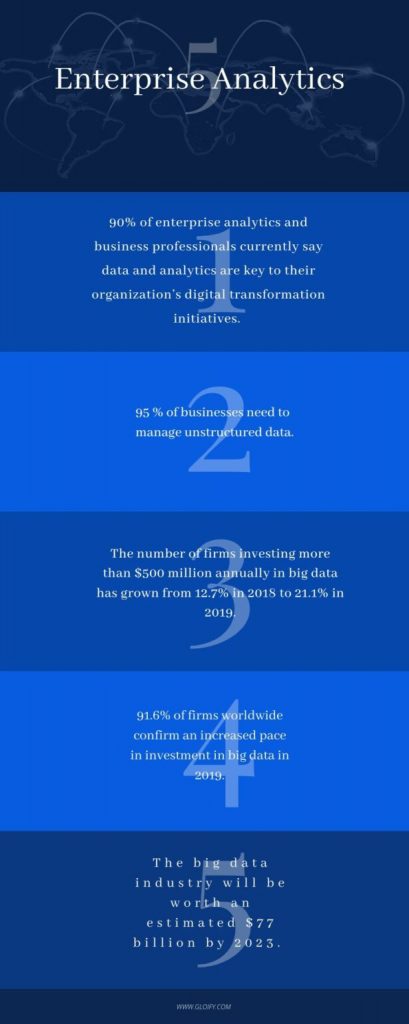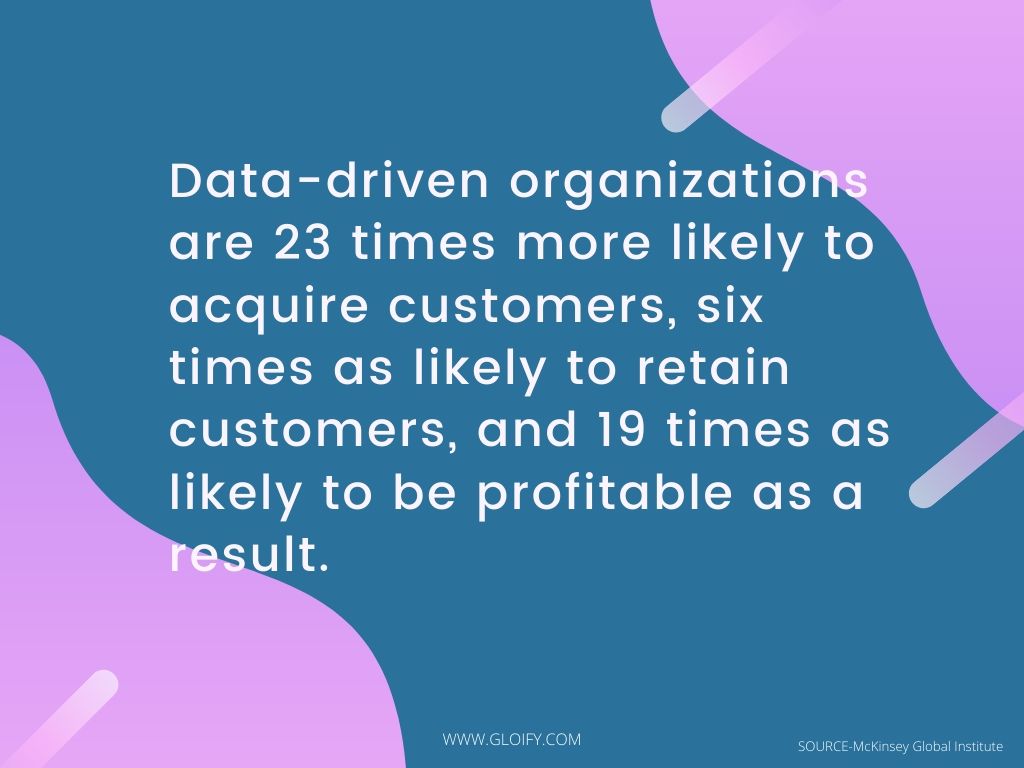Recent technological revolutions such as Facebook, Spotify, Flipkart and Amazon enable us to generate data much faster than ever before. Over the year Data analytics Trends is at high and its application in business intelligence have pulled in huge consideration lately in light of its incredible potential, in producing business impacts and a superior comprehension of information.
Data analytics have been held onto as a problematic innovation that will reshape business intelligence in the coming future, which is a domain that relies on data analytics to gain business insights for better decision-making. Data Analytics offers tremendous possibilities in the present business change. While big data have curiously caught the attention of both practitioners and researchers, especially in the financial services and marketing sectors, there is a myriad of premises that big data analytics can play a much increasingly pivotal job.
Business intelligence and analytics, and its related field have gotten progressively significant in both research and business networks over the previous two decades. Big Data Analytics is an emerging phenomenon with the reported potential to transform how businesses are making the best utilization of huge data. Also, how the organizations oversee and upgrade high-esteem organizations execution with data and business intelligence.
While customer acquisition, investment in enterprise-grade data infrastructure, personalised products were some of the trends from 2018. The year 2019 was extraordinary as far as analytics adoption as the domestic analytics industry saw a huge development growth this year. There has been a noticeable move towards intelligent automation, AI and machine learning that is changing the face of all major sectors. Let us take a look at some of the trends and predictions we can hope to see in the year 2020.
Data Analytics Trends for 2020
-
Augmented Analysis
-
Internet of Things
-
Blockchain
-
Artificial Intelligence
-
In-memory Computing
-
The Rise of Data as a Service
1. Augmented Analytics Is at the upfront of Data Analytics Trends
Augmented analytics is one of the growing trends in data analytics, and with the use of machine learning (ML) and natural language processing (NLP) it enhances data analytics, data sharing and business intelligence. Data analytics software can be easily integrate augmented analytics tools to handle large data sets. Organizations can enter in raw data source information to these platforms that will then scrub, parse and return key information for examination.
According to Gartner, in their October 2018 research “Augmented Analytics” Is the Future of Data and Analytics. Augmented analytics uses machine learning/artificial intelligence (ML/AI) techniques to automate data preparation, knowledge disclosure and sharing. It also automates data science and ML model development, management and deployment.

2. Internet of Things is the next big thing in Data Analytics Trends
With the growing number of cutting edge gadgets and smart devices, data expended and delivered continues developing at a regularly growing rate. This influx of data is filling across the board IoT selection as there will be about 30.73 billion IoT connected devices by 2020.
Internet of Things analytics (IoT analytics) alludes to breaking down examining the data obtained by the Internet of Things. Sensors, network end devices and other data storing and transmitting hardware are the key parts of an assortment of Internet of Things information, whereupon analysis is performed. IoT analytics can be applied to modern robotization, portable applications, cloud solutions and hardware development, in addition to other things.
Data Analytics has a critical task to carry out in the development and achievement of IoT applications and ventures. Analytics tools will allow the business units to make effective use of their datasets.

3. Blockchain Upcoming Trend in Data Analytics
Blockchain has a potential future in data analytics. Modern businesses and organization have been benefiting from data analytics for several years now. According to Forbes, data analytics adoption in enterprises increased from 17% in 2015 to 59% in 2018. Now, only 10% of businesses have refused to utilize big data.
The fusion of data and blockchain technology is poised to grow even more in the next couple of years. According to a report in 2018 shows that 25% of companies are planning to move their analytics platform to the cloud within the next 5 years. And this interest of the organization provides an opportunity for blockchain to display its potential.
A number of banks and health has started their interest in the blockchain, big-name such as PwC has also started testing a blockchain analytics tool to trace digital tokens after its launch. This can help companies safeguard their tokens against risk or being misused for laundering money and other crimes.
4. Artificial Intelligence
Organizations want a more comprehensive analytics strategy to accomplish their business objectives. Figuring out how to incorporate modern machine learning techniques into their data infrastructure is the first step. AI helped to structure the data, One of the most troublesome difficulties faced by organizations in the field of analytics is that data sources have historically been very difficult to analyse.

As data sources are frequently unique and divided, there has been a necessity for manual data cleansing prior to analysis. When it comes to analytics Deep Learning is often raised a potential solution to automatically extract meaningful patterns from large data sets for decision making.
5. In-memory Computing
In-memory computing has the power and potential to change the way data centers are managed. Using in-memory computing to get the best result, form the big data is a challenge for the industries. Few organizations such as Risk and Asset Management firms are already practising in-memory computing to understand the range and probabilities of possible investment outcomes by building complex simulations. With in-memory computing, these simulations can be used to plan the best practices as the computations run a lot quicker.
In-Memory Computing gives super-fast execution and size of ceaseless amounts of data and simplifies access to increasing numbers of data sources. Putting away data in RAM and handling it in parallel, it supplies constant bits of knowledge that empower organizations to convey quick activities and reactions.

6. The Rise of Data as a Service
Data businesses have a few similarities to SaaS organizations yet additionally some huge contrasts as well. Practically all new organizations are set up as a service. Software-as-a-Service like Salesforce, Slack, Google apps, etc. has been on the ascent throughout the previous twenty years.
Businesses and organizations are increasingly providing access to data and digital files on an as-a-service basis, either inside to labourers or financially as an income generator.
And data companies are also becoming services with the acronym “DaaS” for “Data-as-a-Service. Data as a Service will make it easier for analysts to access data for business analysis tasks and easier for departments throughout a business or organization to share data.
These products help organizations in dealing with their own data better. The amount of collected first-party data is growing exponentially due to better tools, internet usage, sensors. Organizations are improving and better about dealing with this first-party information. Simultaneously, figure costs keep on falling significantly consistently so it is less expensive and less expensive to process the data.
According to a Harvard Business Review report, 92 per cent of respondents reported an increase in the pace of their investments in big data; 88 per cent said their organisations faced greater pressure to invest in big data, and 55 per cent reported that their investments in big data had exceeded US$50 million up from US$40 million the previous year.
Yet, on the other hand, data analytics continually grows more complex, as advances in software and methodology enable greater insight, but also greater operational challenges.

